
8 minute read
ECONOMY THE CASE FOR BUILDING GREEN IS BECOMING BLACK AND WHITE The fourth Annual MSCI SA Green Annual Property Index points to an asset class that is becoming more resilient
The case for building green is becoming BLACK AND WHITE
144 Oxford Street in Rosebank, Johannesburg is a nine-storey, 36 000sqm office development with two office wings and a centralised office core with a breath-taking multi-volume atrium. Developed by Growthpoint, this resource-efficient 5-Star Green Star Office Design-v1.1 rated building boasts an energy-efficient façade and features standby power and water. Rainwater is collected and recycled and grey water is re-used. The building’s landscaping incorporates indigenous planting, custom landscape lighting and water features; all serving to soften the transition between public and private space.
Advertisement
The fourth annual MSCI South Africa Green Annual Property Index, released in June this year, found that the green-certified office sample delivered a 34% higher capital value per square metre, more resilient capital growth and a higher net operating income per square metre compared to the non-certified office buildings. These, and other indicators, point to an asset class that is becoming more resilient and more defensive, particularly in adverse conditions, than their less efficient, less agile non-green equivalents. But why is this the case?
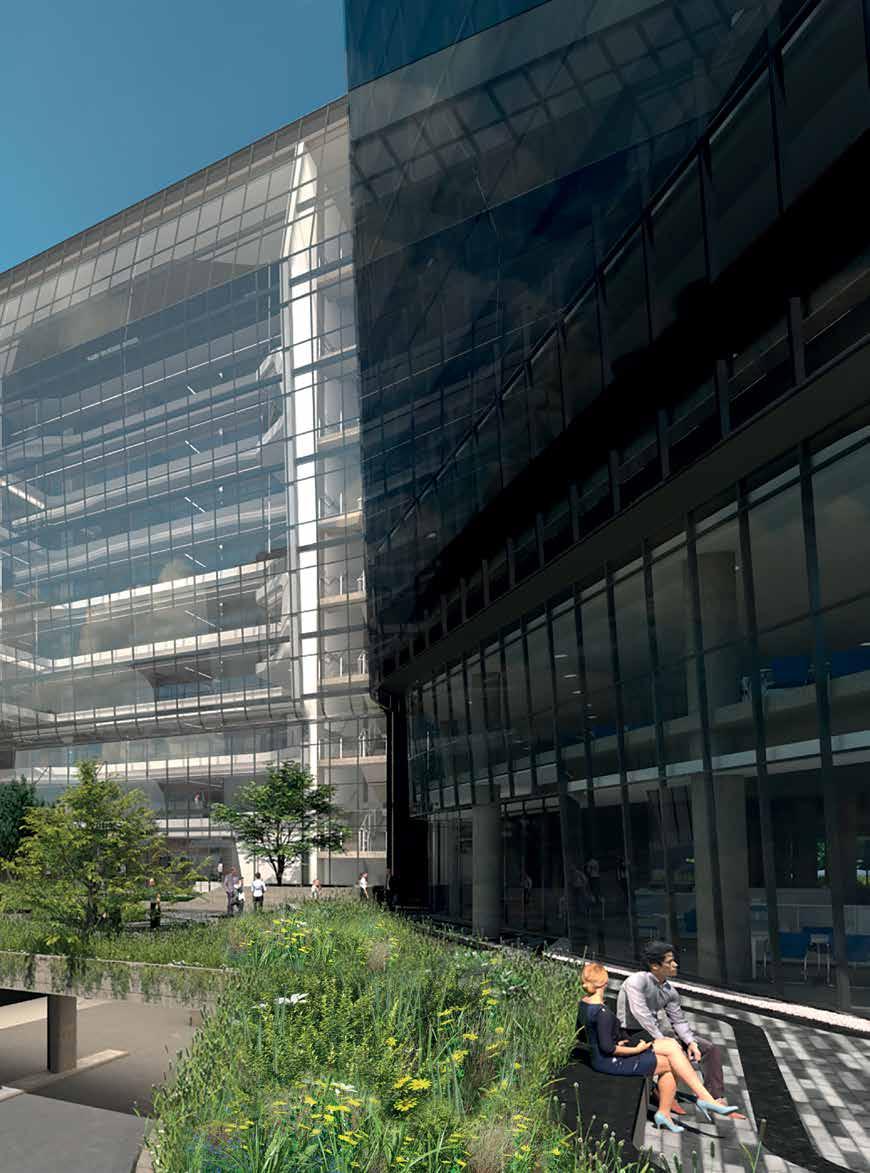
WORDS Gillian Gernetzky IMAGES Growthpoint
The MSCI 2020 ESG Trends to Watch report pinpoints the shift in investing in real estate as one of the five key ESG themes for the year. According to the report, greening of property portfolios will move from a niceto-have reputation booster to an imperative, in the face of a looming “brown discount” as regulators and physical risk deliver a double-whammy on the market.
According to the World Bank, weather-related losses and damage to buildings and infrastructure have risen from an annual average of about $50 billion in the 1980s to close to $200 billion over the last decade. In the case of green, more resilient buildings, lower insurance costs improve returns and lower downtime required for emergency repairs, which increases the bottom line.
At the same time, legislation passed by regions, countries and cities is fast-tracking towards a zerocarbon future. For example, the Green Deal is at the core of the EU’s Covid-19 recovery package, while building a greener, more inclusive, digital and sustainable Europe and increasing resilience to future crises. And New York City’s Climate Mobilisation Act aims to cut buildings’ emissions down by 80% by 2050. Buildings are given a carbon budget and are fined for every ton in breach. In the South African context, Johannesburg is one of 19 global cities that have committed to advocate for all buildings to be net-zero carbon in operation by 2050.
MSCI executive director, Gareth Allison, says that brown discounts are the direct opposite of the green premium that green-certified buildings command. “Initial indications of how decarbonisation efforts have affected the real estate market have been seen for years in what some refer to as a green premium. That is, properties built to high energy standards appear to command a rent premium in some markets. As the market continues to mature in 2020, green buildings may become the new normal, compressing the market into one where a brown discount is put onto buildings struggling to meet new energy standards.”
A brown discount works like this: property values are significantly driven by the present value of future expected cash flow, or net costs, over the anticipated life span of the property. Thus, anything that affects a property’s ability to generate a profit from rental income will ultimately impact its value. Much of the
The 116 000sqm resource-efficient, cost-effective and environmentally-innovative Discovery head office in Sandton, Johannesburg is the largest single-phase commercial office development in Africa. Developed by Growthpoint, the building boasts a 6-Star Green Star Office As Built-v1 rating, and its high-efficiency air conditioning leverages an outside air economy cycle and indoor air CO2 monitoring. Added to this is low-energy lighting, occupant control and daylight optimisation, as well as the building’s standout high-performance double-glazed curtain wall. Grey and rainwater systems, efficient sanitary fittings, efficient irrigation system and water-wise landscaping contribute to the building’s optimal water performance.
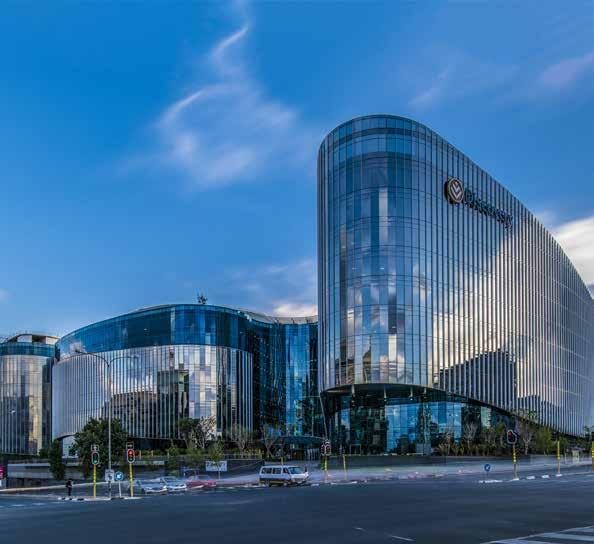
current building stock could face escalating capital and operating costs to meet increasing carbon-emission standards and bolster resistance to climate risks. At the same time, they’re likely to lag in attracting commercial tenants who seek more efficient properties with lower utility costs, higher comfort levels and increased climate resilience, while offering the tenants the potential to improve their own green credentials.
This year’s MSCI index showed that greencertified buildings required comparatively less capital expenditure – 0.7% of the capital value for Green Starcertified buildings, versus 1.2% of the capital value for uncertified buildings – which enhanced their capital growth and is consistent with the rationale behind the brown discount. Vacancy rates were also significantly lower at 8.0% versus the non-green sample vacancy rate of 11.5%, highlighting the value occupiers are attaching to green-certified premises and again supporting this theory.
Eileen Andrew, vice president of Client Coverage at MSCI South Africa concurs, saying that the inherent risk that lies in green-certified buildings is proving to be less than those of non-certified building and this is shown in the lower risk premium. “It has been interesting to see how green-certified buildings have outperformed on the key investment metrics of occupancy – net operating income and operating cost ratios – highlighting these assets’ defensiveness during tough times. The superior capital growth was the result of better net income growth and a lower discount rate – perhaps showing that valuers are adjusting their relative long-term risk assumptions for green-certified buildings,” she says.
An IFC report Green Buildings: A Finance and Policy Blueprint for Emerging Markets published in January this year, found that green buildings have higher rental income than traditional buildings – up to 8% higher and sale premiums up to 31% higher. Green buildings also have higher occupancy rates of up to 23%, higher tenant retention, and lower vacancy rates. Presently, green buildings comprise a relatively small share of global construction – global investments accounted for $423 billion of the $5 trillion spent on building construction and renovation in 2017. However, the market is expected to grow at a compound annual rate of more than 10% between 2017 and 2023, according to the United Nations’ Principles for Responsible Investment.
Exxaro’s headquarters, the conneXXion, in Centurion, Gauteng is a 21 500sqm energy-efficient building fostering a healthy, energising work environment and high productivity levels in a cost-effective setting. Green measures include a performance glazed façade, zoned lighting, energy-efficient building services and systems, waterefficient fixtures, rainwater harvesting, water-wise landscaping, low VOC interior finishes, abundant fresh air and natural light, and a hydro panel that generates water from the air. Developed by Growthpoint, the building achieved a 5-Star Green Star SA Office Design-v1.1 rating and was awarded a “Well Rating” by the Well Institute in the US.
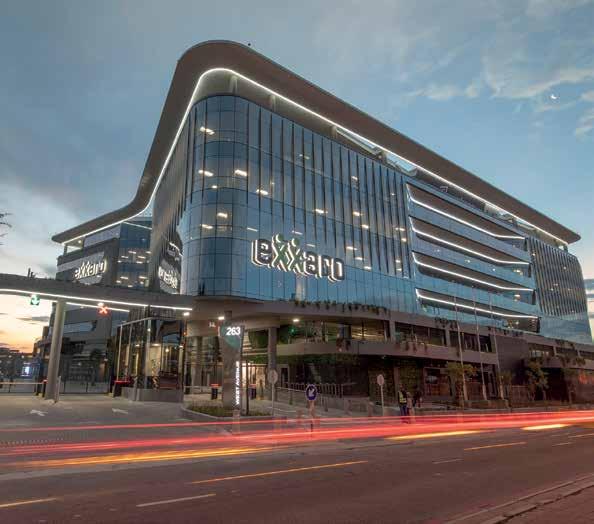
144 Oxford: The nine-storey building is eye-catching and innovative, with its spectacular glass façade extending across the two interlinked towers, which stand with prow-like prominence and present exceptional views across the city.
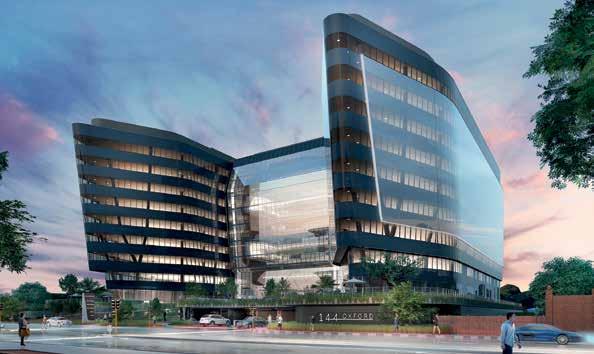
An internal view of 144 Oxford focusing on the high-performance glazed façade.
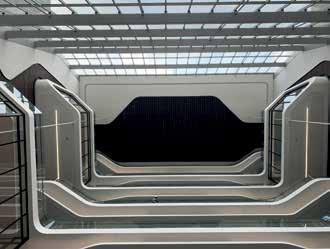
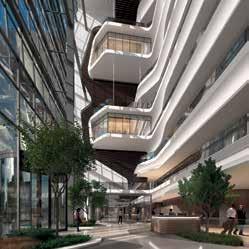
The ground floor podium level of 144 Oxford extends this landscaping, with low planter-walls rising and falling into the floor to create private spaces. All spaces are designed for the people who work in the building to enjoy their lunch breaks and use pause areas.
Georgina Smit, GBCSA head of Sector Development and Market Transformation, adds that the value of certified green buildings is expected to become even more pronounced as the world navigates through the challenges presented by Covid-19. “Post the Covid-19 crisis, many companies are likely to review health measures put in place in their offices. Harvard University recently found that long-term exposure to air pollution is associated with an 8% increase in the Covid-19 death rate, and the improved internal environment quality from increased ventilation, temperature and lighting control, the use of natural light, and the absence of toxic materials result in the improved health, comfort and wellbeing of green building occupants. In a post-pandemic world, these factors can no longer be overlooked. Internal environmental quality is a key consideration within the GBCSA’s Green Star green building frameworks,” she explains.
Allison believes that the business case for green buildings is getting stronger all the time, and screening in favour of sustainability, resilience and future-proofing will become more and more common. “As the bar shifts, it will become the new standard.
The day will come when no one will want to own or occupy the ‘brown’ buildings and infrastructure. Then those will increasingly be sold at a discount – or updated at substantial cost. Buildings that are designed with the future in mind, with smart building technology and interactivity integrated throughout, making them as responsive and adaptable to the needs of the workforce in a post-Covid-19 world today as those in the future, are more resilient and less likely to become stranded assets that no asset manager or building owner wants.”









